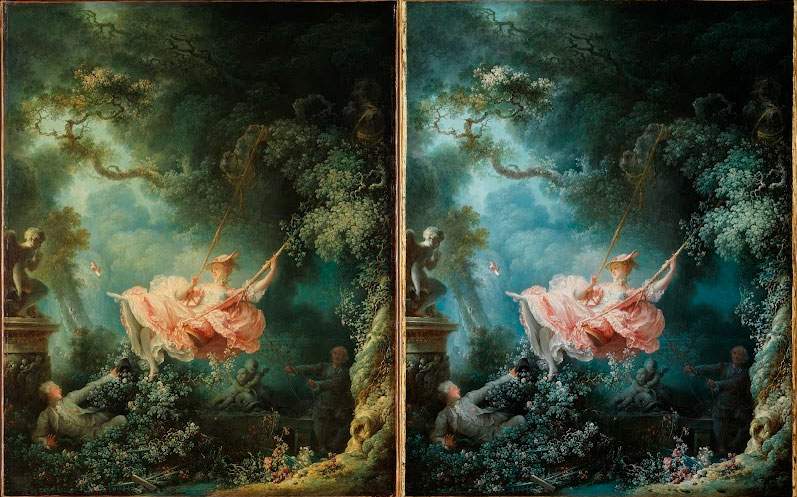London, restored Fragonard's Swing, iconic Rococo masterpiece
The Swing by Jean-Honoré Fragonard (Grasse, 1732 - Paris, 1806), an iconic masterpiece of 18th-century France held at the Wallace Collection in London (a museum that preserves the most substantial nucleus of Fragonard’s works outside France), has returned to public display after a major restoration. Les hasards heureux de l’escarpolette (this is the painting’s original title), painted circa 1767-1768, has in fact undergone its first major conservation intervention (preceded by careful diagnostic investigations), thanks in part to resources made available by the Bank of America Art Conservation Project.
The celebrated Swing is the most iconic painting of the entire Rococo movement and one of the most famous works of art in the Wallace Collection: references to this masterpiece can be found in literature, contemporary art, design, and film. It is sought after and admired by thousands of visitors every year: many people come to the Wallace Collection specifically to see it. However, despite its fame, relatively little is known about the painting. The circumstances of its commission are vague, with Fragonard choosing to undertake a painting that other “academic” painters had rejected because of its scandalous subject matter. Fragonard’s methods in constructing the composition are also unclear. In addition, the paint surface before the intervention was clouded by yellowed varnish and old retouches.
The restoration work took place over the summer within the Wallace Collection, and it was handled by Martin Wyld, formerly head of Conservation at the National Gallery, where he worked for more than four decades restoring works by artists such as Leonardo and Velázquez. The investigation shed light on the doubts that hovered around TheSwing and allowed us to better understand Fragonard’s work as well as his way of working. The removal of yellowed varnish, they let the Wallace Collection know, literally transformed the painting. The white lace of the young girl’s dress on the swing can now be seen sharply, the composition has taken on a new sense of depth, background details are now evident, and the overall freshness and texture of the artist’s paint surface have been restored. Few preliminary or preparatory studies have been identified: indeed, it appears that Fragonard worked confidently and skillfully, directly on the canvas, to create his best-known masterpiece.
The painting now regains its place in the Wallace Collection (the room that houses it also has a new lighting system) along with the museum’s seven other Fragonard works, allowing visitors to see for the first time how the artist’s journey developed throughout his career. The return of theSwing is accompanied by a special season of events, including free public talks with special guests and more.
“We approached the preservation of Fragonard’s masterpiece,” said Xavier Bray, director of the Wallace Collection, “with great sensitivity and a keen awareness of our responsibility to the public to preserve this iconic painting. The results have been astonishing and the true genius of Fragonard has been revealed. I urge you to visit, look at The Swing again and fall in love with Fragonard all over again.”
“Fragonard is an elusive artist who has fascinated me throughout my career,” says Yuriko Jackall, curator of French paintings at the Wallace Collection. “He is so varied, unpredictable and skillful. He has left us very little documentary evidence about his life and working methods, so we have been looking for answers in his own work. Although more research remains to be done, I am excited about the impact a closer look at The Swing will have on the public and on Fragonard in general.”
“At Bank of America,” emphasizes Andrea Sullivan, Head of International Environment, Social & Governance at Bank of America, “we believe in the power of the arts to help economies thrive, unite communities, and promote greater cultural understanding. We are pleased to support the preservation of this inimitable masterpiece, restoring it to its former glory, helping to ensure that more people will appreciate it for many years to come.”
Pictured is Fragonard’sSwing before and after restoration.
 |
| London, restored Fragonard's Swing, iconic Rococo masterpiece |
Warning: the translation into English of the original Italian article was created using automatic tools. We undertake to review all articles, but we do not guarantee the total absence of inaccuracies in the translation due to the program. You can find the original by clicking on the ITA button. If you find any mistake,please contact us.




























